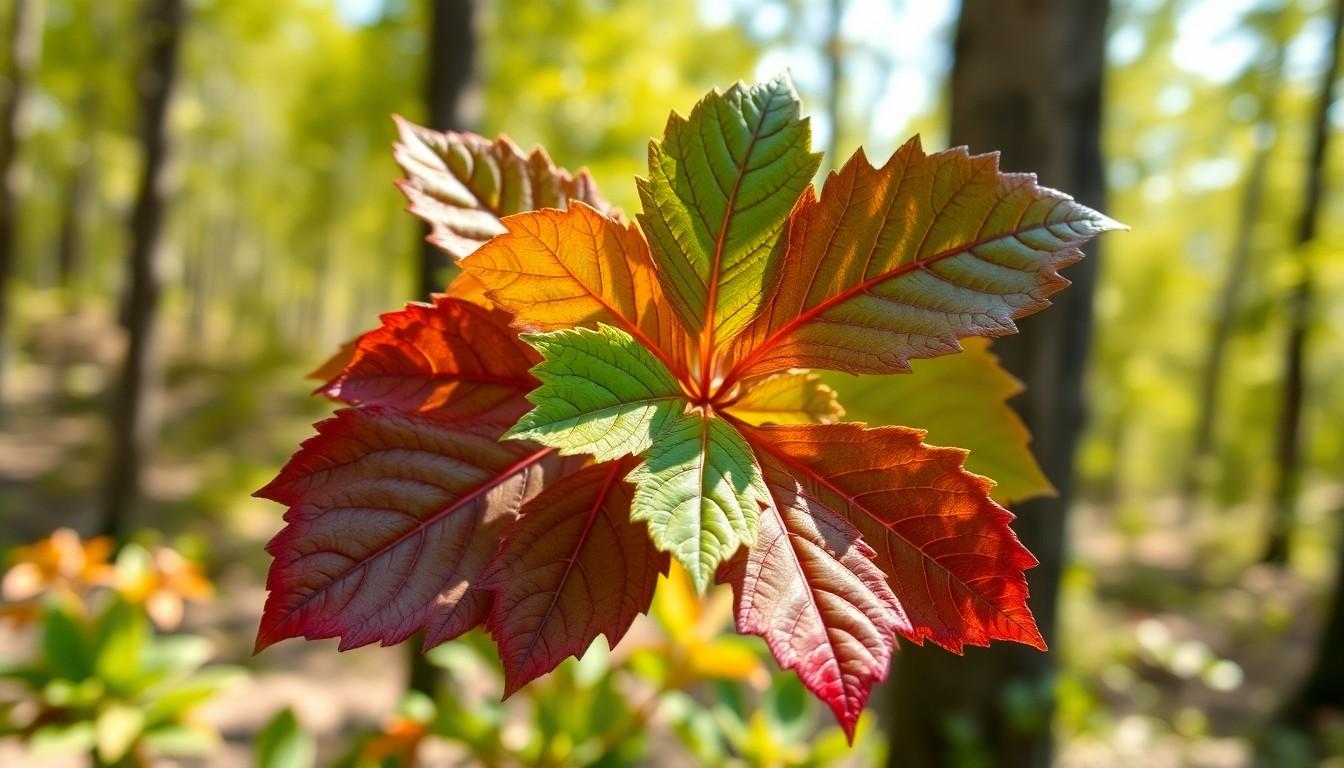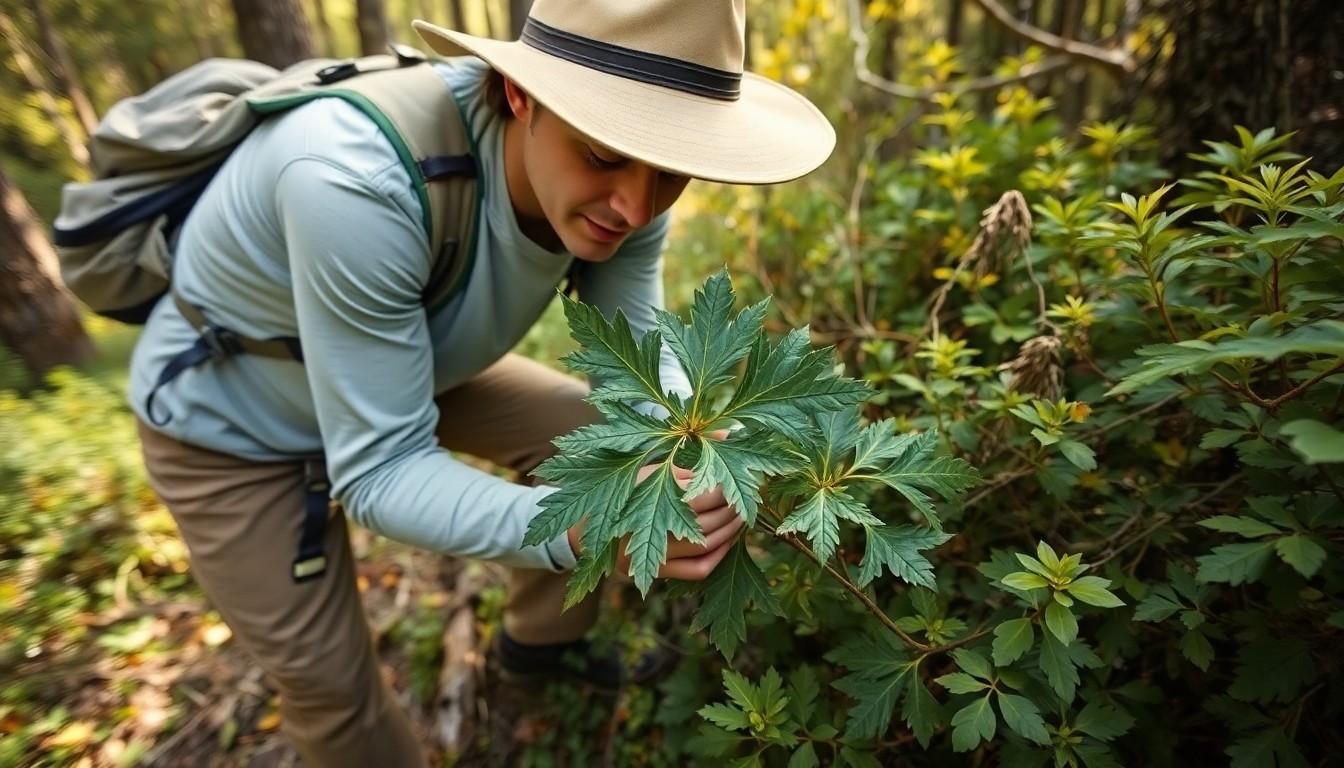When hiking through the great outdoors, the last thing anyone wants is an unexpected encounter with poison oak. This sneaky plant loves to play hide-and-seek, often disguising itself among other foliage. But fear not! With a little knowledge, anyone can become a poison oak detective, spotting its telltale signs before it strikes.
Overview of Poison Oak
Poison oak (Toxicodendron diversilobum) is a toxic plant found predominantly in the western United States. Its leaves typically appear in clusters of three, but five-leaf variations can occur, which complicates identification. Identifying these plants is essential for preventing skin reactions in sensitive individuals.
Leaves display a glossy surface and can vary in size and shape. Green leaves turn red or orange in the fall, providing a seasonal indicator. The shape of the leaves resembles a small oak leaf, aiding in its name, yet it can adapt to its environment, appearing differently based on light and moisture levels.
Additionally, poison oak can grow as a shrub or climbing vine. Growth patterns depend on environmental conditions, meaning it can thrive in various habitats, including forests, grasslands, and along trails. When hiking, pay close attention to leaf clusters and the plant’s height when evaluating surroundings.
Flowers usually bloom in spring, producing small, white or yellow clusters. Following the flowering stage, berries develop, attracting birds while remaining hazardous to humans. Brush up on characteristics to minimize risks associated with this plant.
Avoiding poisonous contact requires advanced awareness of poison oak. Recognizing its unique traits such as leaf structure and growth form becomes vital for outdoor enthusiasts. Mastering plant identification can significantly reduce unexpected encounters with poison oak.
Characteristics of Poison Oak

Poison oak exhibits distinct features that help in its identification, particularly when hiking. Understanding these characteristics aids in preventing contact with this toxic plant.
Leaf Structure
Leaves of poison oak typically grow in clusters of three, but five-leaf variations exist. Leaf edges range from smooth to irregularly lobed. Glossy surfaces may also shift colors from green to reddish in fall. Each leaf can measure between 1 to 5 inches in length, enhancing its variability. Notably, identifying the leaf structure proves critical for distinguishing poison oak from similar plants.
Stem and Bark Features
Stems can take on different forms, growing as low shrubs or climbing vines. Bark appears light brown or gray, often with a somewhat hairy texture. In some cases, stems may exhibit a slight reddish hue. Thickness ranges from slender to robust, depending on the plant’s growing conditions. Observing these traits contributes to accurate identification and awareness of poison oak.
Common Locations
Poison oak thrives in diverse environments across the western United States. Often found in wooded areas, the plant also occupies fields and along hiking trails. Preferring sunny spots, it can grow in shaded locations as well. Disturbed soils, such as those affected by fire or construction, create ideal habitats. Recognizing these common locations plays a vital role in avoiding encounters with poison oak while exploring the outdoors.
Identifying Poison Oak
Recognizing poison oak is crucial for outdoor safety. Understanding its characteristics helps avoid allergic reactions caused by contact with the plant.
Five Leaf Pattern
Some variations of poison oak display a five-leaf pattern. This can confuse identification since many assume the plant only has clusters of three leaves. Leaf shapes may vary from smooth to lobed, typically measuring between 1 to 5 inches in length. Not everyone knows that poison oak can also look like a harmless vine or shrub. Observing the leaf arrangement and form is important for accurate identification.
Seasonal Changes
Poison oak undergoes significant changes with the seasons. In spring, new leaves emerge bright green, while summer brings a glossy texture. As autumn arrives, leaves transition to vibrant reds and yellows. Recognizing these seasonal variations aids in identification, making it easier for hikers to spot poison oak. The plant’s white or yellow flowering clusters appear in early spring, followed by small berries that develop later. Each stage offers distinct characteristics vital for honing identification skills.
Confusing Look-Alikes
Identifying poison oak can get tricky due to its look-alikes. Both poison ivy and sumac share similarities, which pose challenges for outdoor enthusiasts.
Poison Ivy
Poison ivy (Toxicodendron radicans) features leaf clusters that typically consist of three leaflets, but variations can appear. This plant grows in various habitats, often in wooded areas or along trails. Smooth to slightly serrated edges characterize its leaves, which present a glossiness that varies seasonally. In spring and summer, poison ivy shows bright green leaves that turn vibrant red in fall. Contact can lead to rashes, similar to poison oak reactions. It’s important to stay alert, as both plants can grow as low shrubs or climbing vines.
Sumac
Sumac (Rhus spp.) includes numerous species known for their cluster formations. The leaves are arranged in a pinnate structure with 5 to 13 leaflets, giving them a distinct appearance. Unlike poison oak, sumac’s leaflets have a smooth surface and lack the lobed edges of poison oak leaves. Sumac typically grows in sunny areas and is often found near roadways and fields. In the fall, sumac turns a brilliant red, making it visually appealing but confusing when identifying plants in the wild. Avoiding contact with sumac is crucial, as it can also cause skin irritations, albeit less severe than those from poison ivy or poison oak.
Safety and Precautions
Recognizing poison oak is crucial for safety in outdoor settings. Avoiding contact with the plant reduces the risk of allergic reactions. Wearing protective clothing, such as long sleeves and pants, minimizes skin exposure when hiking in areas where poison oak is likely present.
Identifying the five-leaf variety can be challenging. Observing the leaf shapes and colors aids in distinguishing poison oak from similar plants. Carrying identification guides or using smartphone apps enhances the ability to recognize these plants accurately.
If contact occurs, washing the skin with soap and water within 30 minutes helps remove the plant’s oils. Using specialized cleansers can further reduce the chances of developing a rash. Keeping pets away from poison oak is essential since their fur can carry the oils into homes.
Staying informed about the plant’s growth habits and seasonal changes strengthens identification skills. Recognizing the glossy foliage and understanding habitat preferences improve awareness. Noticing the distinctive clusters of leaves and their color shifts during autumn is beneficial.
Other plants in proximity may share characteristics with poison oak. Consulting resources about poison ivy and sumac can clarify potential mix-ups. Observing the differences between these plants enhances overall safety and supports informed decisions in nature.
Being diligent about personal hygiene after outdoor activities can prevent lingering reactions. Changing clothes and showering reduces the transfer of any lingering irritants. Maintaining awareness and respect for the natural environment fosters safer outdoor experiences.
Conclusion
Recognizing poison oak is essential for anyone who enjoys the outdoors. Its five-leaf variations can cause confusion but understanding its unique characteristics helps minimize risks. By familiarizing themselves with the plant’s appearance and growth habits hikers can navigate trails safely.
Taking precautions like wearing protective clothing and carrying identification tools further enhances safety. Being proactive in washing off any potential oils after contact can prevent uncomfortable reactions. With awareness and respect for the environment outdoor enthusiasts can enjoy their adventures while avoiding the pitfalls of poison oak.

